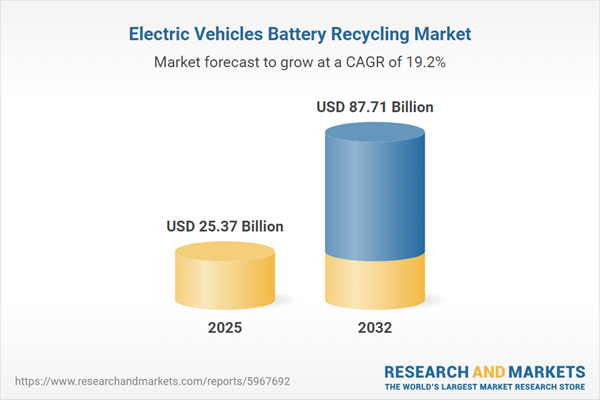Speak directly to the analyst to clarify any post sales queries you may have.
As stakeholders across the mobility sector pursue sustainability, the electric vehicles battery recycling market is quickly gaining prominence, driven by regulatory, economic, and technological imperatives. Senior decision-makers require actionable insights to navigate evolving policy, emerging partnerships, and investment priorities.
Market Snapshot: Electric Vehicles Battery Recycling Market
The electric vehicles battery recycling market expanded from USD 21.55 billion in 2024 to USD 25.37 billion in 2025 and is forecast to sustain a 19.17% CAGR, targeting USD 87.71 billion by 2032. This robust growth highlights rapid electrification, heightened resource recovery needs, and intensifying efforts to close material loops as key industry drivers. Senior executives are adjusting business strategies to align with evolving regulations and supply chain demands while leveraging advancements for operational agility.
Scope & Segmentation
This comprehensive research examines the electric vehicles battery recycling market across technologies, business models, and regional landscapes. Major segmentation pillars include:
- Battery Type: Covers lead-acid batteries, lithium-ion batteries, and nickel-metal hydride batteries, each presenting distinct recycling challenges and value propositions.
- Recycling Process: Evaluates direct recycling, hydrometallurgical, and pyrometallurgical processes for material recovery efficiency and environmental impact.
- Source: Distinguishes between end-of-life batteries and production scrap, with each origin affecting collection, processing, and investment dynamics.
- End-User: Profiles automobile manufacturers, battery producers, dismantlers & scrap yards, and dedicated recycling firms collaborating for closed-loop solutions and supply security.
- Vehicle Type: Assesses commercial and passenger electric vehicles, reflecting variations in battery scale, collection logistics, and service models.
- Regional Analysis: Spans the Americas, Europe Middle East & Africa, and Asia-Pacific, emphasizing distinct market catalysts, policy settings, and infrastructure readiness across North America, Latin America, Europe, the Middle East, Africa, China, India, Japan, Australia, South Korea, Indonesia, Thailand, Malaysia, Singapore, and Taiwan.
- Leading Companies: Tracks innovation from firms such as American Battery Technology Company, Li-Cycle Corp., Contemporary Amperex Technology Co., Limited, and Umicore N.V., complemented by entries from organizations like Aqua Metals, GEM Co., Ltd., Neometals Ltd., and Tata Chemicals Limited.
Key Takeaways for Senior Decision-Makers
- Battery recycling has transitioned from a compliance obligation to a core strategy, supporting supply chain resilience and sustainable growth.
- Collaborative alliances among automakers, recyclers, and chemical companies are critical to overcoming raw material scarcity and improving recovery efficiency.
- Regulatory developments, particularly regarding extended producer responsibility and carbon border measures, are directly influencing capital flows and facility siting.
- Advancements in hydrometallurgical and direct recycling technologies are reshaping material recovery, reducing energy use and enabling selective extraction of valuable metals.
- Regional variations require tailored approaches; while the Americas focus on domestic integration, Europe prioritizes regulatory compliance, and Asia-Pacific drives rapid capacity scale-up and process innovation.
- Emerging digital platforms and data analytics are enhancing traceability, supply assurance, and real-time compliance monitoring throughout the battery lifecycle.
Tariff Impact: Addressing Cost and Strategic Realignment
U.S. tariffs set for 2025 are projected to elevate input costs across core battery recycling streams. Industry participants are actively restructuring sourcing, growing domestic partnerships, and investing in local infrastructure to insulate operations from volatility. These tariff changes are promoting innovation in recovery technologies and prompting strategic discussions about harmonizing standards for cross-border material flows and negotiating future exemptions.
Methodology & Data Sources
The electric vehicles battery recycling market analysis combines primary expert interviews, secondary source validation, and qualitative and quantitative assessment. Research draws from executive perspectives, industry data, policy documents, and technical publications. Scenario modeling and sensitivity analysis ensure strategic recommendations reflect market realities.
Why This Report Matters
- Enables decision-makers to anticipate regulatory shifts, optimize supply chain investments, and capture emerging opportunities through actionable insights.
- Facilitates cross-sector collaboration and technology selection for competitive differentiation in a dynamic recycling environment.
- Equips organizations with clear visibility on major players, innovation pathways, and region-specific growth drivers to inform robust strategic planning.
Conclusion
Electrification and sustainability imperatives are redefining the electric vehicles battery recycling market. Industry leaders who align technology, policy awareness, and partnership strategies will be best positioned to achieve long-term competitiveness and responsible growth.
Additional Product Information:
- Purchase of this report includes 1 year online access with quarterly updates.
- This report can be updated on request. Please contact our Customer Experience team using the Ask a Question widget on our website.
Table of Contents
3. Executive Summary
4. Market Overview
7. Cumulative Impact of Artificial Intelligence 2025
Companies Mentioned
The companies profiled in this Electric Vehicles Battery Recycling market report include:- ACCUREC-Recycling GmbH
- Akkuser Oy
- American Battery Technology Company by Komatsu Ltd.
- Aqua Metals, Inc.
- Attero Recycling Pvt. Ltd.
- Batrec Industrie AG
- Battery Recyclers of America
- Cirba Solutions by Battery Solutions, LLC
- Contemporary Amperex Technology Co., Limited
- Duesenfeld GmbH
- Ecobat, LLC
- Envirostream Australia Pty Ltd. by Lithium Australia NL
- F & R Cawley Ltd. by SUEZ Recycling and Recovery
- Fortum Corporation
- Ganfeng Lithium Group Co., Ltd.
- GEM Co., Ltd.
- Li-Cycle Corp.
- Lithion Technologies
- Neometals Ltd.
- OnTo Technology LLC
- RecycLiCo Battery Materials Inc.
- SMCI Group
- Stena Metall Group
- Sumitomo Metal Mining Co., Ltd.
- Tata Chemicals Limited
- TES Group by SK Ecoplant
- Umicore N.V.
- Toshiba Corporation
Table Information
| Report Attribute | Details |
|---|---|
| No. of Pages | 190 |
| Published | November 2025 |
| Forecast Period | 2025 - 2032 |
| Estimated Market Value ( USD | $ 25.37 Billion |
| Forecasted Market Value ( USD | $ 87.71 Billion |
| Compound Annual Growth Rate | 19.1% |
| Regions Covered | Global |
| No. of Companies Mentioned | 29 |









